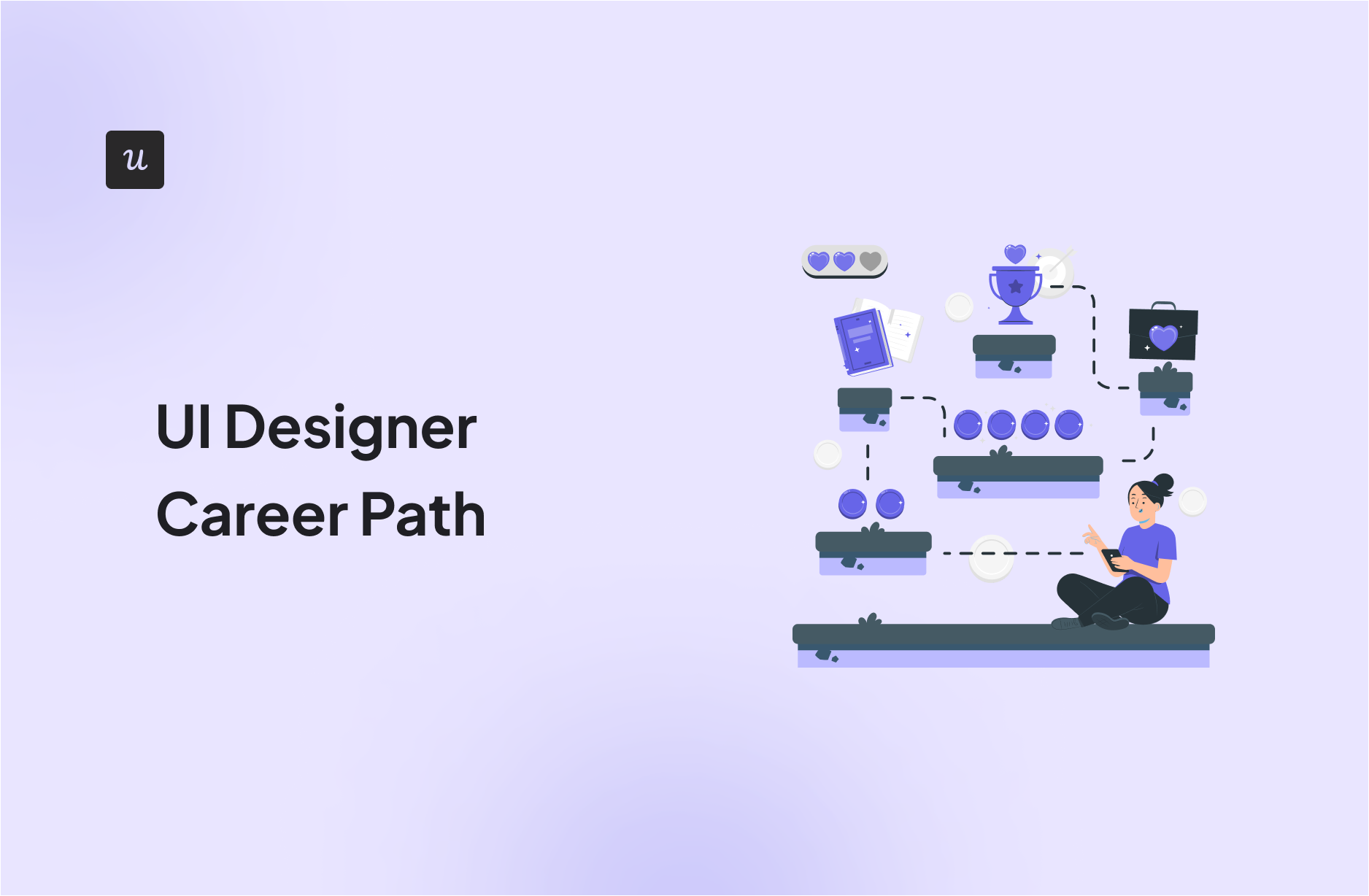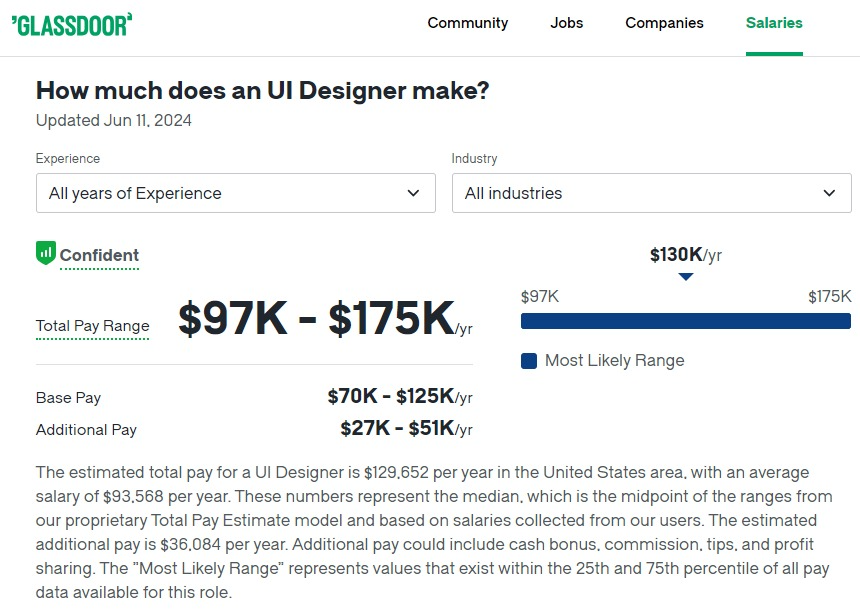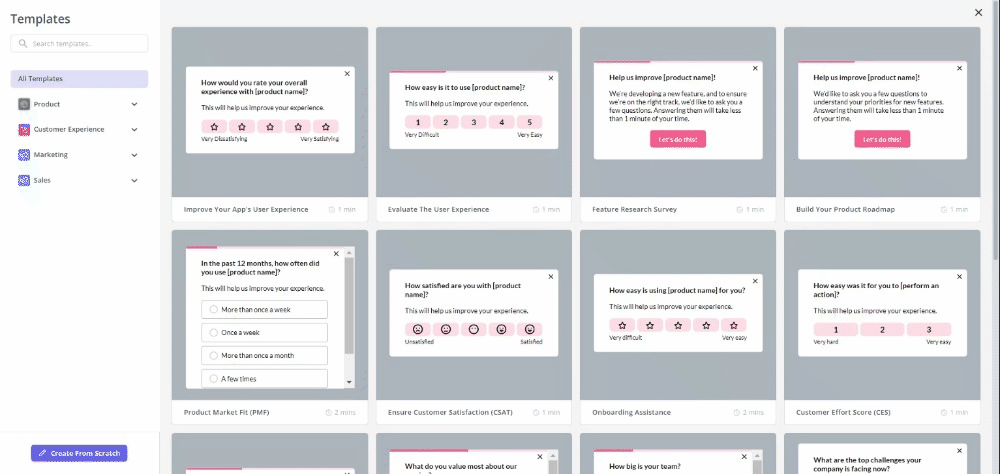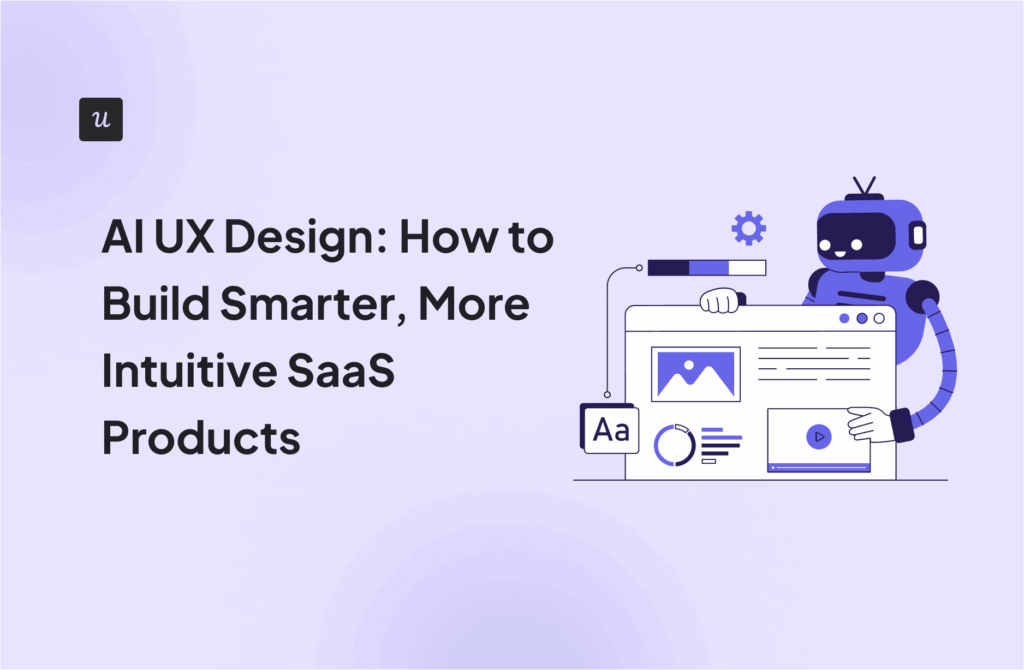
Try Userpilot Now
See Why 1,000+ Teams Choose Userpilot

UI designer career path – summary
- A UI (User Interface) designer focuses on creating visually appealing and interactive elements for digital products. They design the layout, visual elements, and interactive features to ensure the product is user-friendly and aesthetically pleasing.
- One of the biggest factors influencing your salary is your experience level. Here’s how experience can impact your UI designer salary:
- 2 to 4 years (Junior UI Designer): $60,000 – $77,007 per year
- 5 to 7 years (Senior UI Designer): $109,880 – $156,322 per year
- A career in UI design involves progressing through various roles, each with increasing responsibility and expertise. Here’s a typical career progression for a UI Designer:
- Junior UI Designer
- UI Designer
- Senior UI Designer
- Lead UI Designer
- UI Design Manager
- Director of UI Design
- To become a UI designer, start by obtaining a degree in design, human-computer interaction, or a related field. Gain practical experience through internships at tech companies, design firms, or startups where you can work on real projects and build a strong portfolio.
- Having the right tools is crucial for UI Designers to enhance productivity, creativity, and collaboration. Here are some of the best tools tailored for specific use cases:
- Best tool for User Onboarding and Engagement – Userpilot
- Best tool for Project Management – Monday
- Best tool for Product Management – Jira Software
- Best tool for Customer Experience – Zendesk
- Best tool for UX/UI Design – Figma
- Best tool for UX/UI Design – Sketch
- Looking into tools for UI designers? Userpilot is an all-in-one product platform with engagement features and powerful analytics capabilities. Book a demo to see it in action!
What is a UI designer?
A UI (User Interface) designer focuses on creating visually appealing and interactive elements for digital products. They design the layout, visual elements, and interactive features to ensure the product is user-friendly and aesthetically pleasing.
UI designers collaborate closely with UX Designers to ensure a cohesive and engaging user experience.
What does a UI designer do?
A UI designer creates the visual aspects and interactive elements of digital products.
They design the layout, choose color schemes, select typography, and develop buttons, icons, and other graphical elements to create an intuitive and engaging interface.
UI designer’s main responsibilities
A UI designer is essential in the SaaS industry for creating intuitive and engaging user interfaces. Here are the main responsibilities and duties of a UI Designer:
- Design User Interfaces: Develop visually appealing and user-friendly interfaces.
- Create Wireframes and Prototypes: Design wireframes, mockups, and interactive prototypes.
- Collaborate with Teams: Work closely with UX designers, product managers, and developers.
- Maintain Design Systems: Create and manage design systems and style guides.
- Stay Updated with Trends: Keep abreast of the latest design trends, tools, and technologies.
- Document Design Processes: Maintain clear documentation of design processes, decisions, and guidelines.
UI designer salary
One of the biggest factors influencing your salary is your experience level. Here’s how experience can impact your UI designer salary:
- 2 to 4 years (Junior UI Designer): $60,000 – $77,007 per year
- 5 to 7 years (Senior UI Designer): $109,880 – $156,322 per year
Industries where the demand for UI professionals is highest tend to be the same industries that pay the most on average:
- Finance and Insurance: $80,034 per year
- Professional, Scientific, and Technical Services: $78,332 per year
- Information Technology: $93,849 per year
Where you live can have a big impact on how much you make as a UI designer:
- San Francisco: $95,071 per year
- New York: $80,187 per year
- Boston: $77,931 per year
- Washington, DC: $78,323 per year
- Chicago: $76,022 per year
UI designer career path
A career in UI design involves progressing through various roles, each with increasing responsibility and expertise. Here’s a typical career progression for a UI Designer:
- Junior UI Designer: Assists in designing interfaces, creates basic wireframes, and supports senior designers. To progress, build a strong portfolio, seek feedback, and gain practical experience through internships or entry-level positions.
- UI Designer: Conducts user research, creates wireframes and prototypes, and collaborates with cross-functional teams. To advance, take on more complex projects, refine your skills, and develop a deeper understanding of UI principles and methodologies.
- Senior UI Designer: Leads major design projects, mentors junior designers, and plays a key role in strategic planning. To progress, enhance leadership skills, contribute to creating design systems, and build strong relationships with product managers and developers.
- Lead UI Designer: Oversees the design team, ensures design consistency, and aligns design goals with business objectives. Develop project management skills, drive innovation within the team, and engage in high-level strategic planning.
- UI Design Manager: Manages the UI design team, coordinates design efforts across projects, and ensures alignment with overall business strategy. Enhance managerial skills, stay updated with industry trends, and focus on optimizing team performance and design processes.
- Director of UI Design: Sets the overall design strategy for the organization, collaborates with top executives, and ensures the design vision aligns with the company’s mission. Focus on strategic leadership, expand influence across departments, and drive the company’s design innovation.
Each step in this career path builds on the previous one, emphasizing continuous learning, leadership, and strategic thinking to progress to higher levels of responsibility and influence in the field of UI design.
How to become a UI designer
To become a UI Designer, start by obtaining a degree in design, human-computer interaction, or a related field. Gain practical experience through internships at tech companies, design firms, or startups where you can work on real projects and build a strong portfolio.
Consider taking online courses or certifications in UI design to enhance your skills. Networking through industry events, joining professional organizations, and staying updated with the latest trends and tools in UI design will also boost your career prospects.
Best resources for UI designers
To stay ahead in the dynamic field of UI design, it’s crucial to leverage various resources for continuous learning and inspiration.
Here are some top recommendations for books, webinars, podcasts, and blogs that every UI designer should explore.
Best books for UI designers
Books are a great way to dive deep into UI design principles and practices. Here are some essential reads:
- “The Design of Everyday Things” by Don Norman – Explores the principles of good design and user experience.
- “Don’t Make Me Think” by Steve Krug – Focuses on web usability and intuitive design.
- “Refactoring UI” by Adam Wathan and Steve Schoger – Provides practical advice on improving the design of web applications.
- “Sprint” by Jake Knapp – Details a five-day process for solving tough problems through design, prototyping, and testing.
- “Hooked: How to Build Habit-Forming Products” by Nir Eyal – Discusses the psychology behind user habits and creating engaging products.
Best webinars for UI designers
Webinars offer real-time learning and insights from industry experts. Here are some top webinars for UI designers:
- Userpilot Webinars – Focus on user onboarding, engagement, and product growth.
- NNG (Nielsen Norman Group) Webinars – Expert insights on various UX and UI topics, including usability and design research.
- Interaction Design Foundation Webinars – Covers a wide range of UI/UX design principles.
- Adobe Webinars – Tutorials and insights on using Adobe design tools effectively.
- Smashing Magazine Webinars – In-depth discussions on UI design, web development, and related topics.
Best blogs for UI designers
Following blogs can help you stay updated on the latest trends, tips, and best practices in UI design. Here are some must-read blogs:
- Userpilot Blog – Insights on user onboarding, product growth, and UI/UX design.
- Smashing Magazine – Covers a wide range of topics, including UI design, web development, and product management.
- NNG (Nielsen Norman Group) Blog – Research-based articles on UX and UI design and usability.
- UX Design.cc – A community-driven platform with articles on UI and UX design.
- A List Apart – Explores the design, development, and meaning of web content, with a focus on best practices and web standards.
Best podcasts for UI designers
Listening to podcasts is a convenient way to stay informed and inspired by industry leaders while on the go. Here are some recommended podcasts:
- “Design Better Podcast” by InVision – Interviews with design leaders discussing the craft and business of design.
- “UI Breakfast” – Conversations about UI/UX design, product strategy, and business.
- “Layout” – Covers a wide range of topics related to design, development, and everything in between.
- “User Defenders” – Interviews with UX design heroes sharing their stories and insights.
- “The Crazy One” – Hosted by Stephen Gates, covering creativity, leadership, and innovation in design.
Best tools for UI designers
Having the right tools is crucial for UI Designers to enhance productivity, creativity, and collaboration. Here are some of the best tools tailored for specific use cases:
- Best tool for User Onboarding and Engagement – Userpilot: Userpilot helps UI designers create personalized in-app experiences and smooth onboarding processes. It allows for real-time user feedback and insights to improve user engagement and retention.
- Best tool for Project Management – Monday: Monday.com offers a visual and flexible platform for managing projects and tasks. It’s ideal for UI designers to track project progress, collaborate with team members, and meet deadlines.
- Best tool for Product Management – Jira Software: Jira Software is perfect for tracking and managing design tasks, user stories, and sprints. It ensures seamless communication between designers and developers, facilitating efficient project workflows.
- Best tool for Customer Experience – Zendesk: Zendesk provides comprehensive customer support solutions. UI designers can use it to gather and analyze user feedback and support tickets, identifying areas for improvement in the user experience.
- Best tool for UX/UI Design – Figma: Figma supports real-time collaboration on design projects, making it ideal for creating wireframes, prototypes, and high-fidelity designs. It allows for easy sharing and feedback collection.
- Best tool for UX/UI Design – Sketch: Sketch is a vector graphics editor tailored for digital design. It’s highly suitable for creating detailed UI designs and offers numerous plugins.
Conclusion
We hope our article has given you a good overview of the career path for UI designers.
Whether you’re just starting out or looking to advance, the key is to stay curious, keep learning, and remain open to new opportunities along the way.
Looking into tools for UI designers? Userpilot is an all-in-one product platform with engagement features and powerful analytics capabilities. Book a demo to see it in action!










